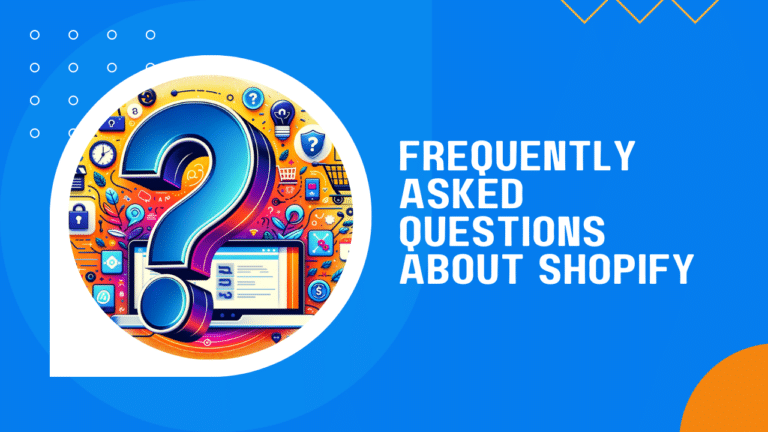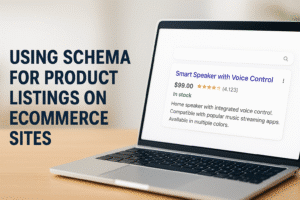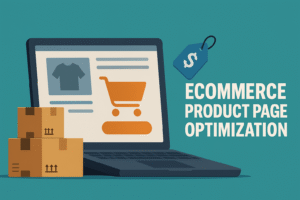Starting an online store on Shopify is an exciting step for any business, but it often comes with a lot of questions. Whether you’re new to eCommerce or looking to improve your existing Shopify store, understanding the basics and best practices is key to success. In this guide, we’ll answer some of the most frequently asked questions about selling on Shopify, from setting up your store to optimizing your sales strategies.
But selling online isn’t just about having a great website; it’s also about efficiently managing the orders that come through it. That’s where order fulfillment services like ShipBuddies can make a big difference. As we go through these FAQs, we’ll also shed light on how integrating a service like ShipBuddies can streamline your shipping and fulfillment process, giving you more time to focus on growing your business.
Let’s dive into these questions and help you make the most of your Shopify experience.
FAQs About Setting Up a Shopify Store
How do I start selling on Shopify?
Starting a store on Shopify is straightforward. First, sign up for a Shopify account. Once you’re logged in, you can choose a theme for your store, customize it to fit your brand, add products, set up payment methods, and configure shipping options. Shopify offers a range of tutorials and support to guide you through the setup process.
How much does Shopify cost?
Shopify offers various pricing plans to suit different business needs and budgets, making it accessible for startups as well as established businesses. The main plans are:
- Basic Shopify: Ideal for new businesses or online stores with a limited number of products. This plan includes all the basic features needed to start a new online store.
- Shopify: Suitable for growing businesses with a larger number of products and higher sales volume. This plan offers additional features like professional reports and better rates on shipping and payment processing.
- Advanced Shopify: Best for scaling businesses that require advanced reporting and analytics. This plan offers the lowest transaction fees and the best shipping rates.
Each plan includes web hosting, SSL certificate, and access to Shopify’s suite of tools for setting up and managing your online store. Additionally, Shopify offers an enterprise solution known as Shopify Plus for high-volume merchants and large businesses.
It’s important to note that the costs can vary based on additional factors such as the use of paid themes, third-party apps, and transaction fees. For the most current pricing and features, it’s recommended to visit Shopify’s official website.
What are the essential features I should set up in my Shopify store?
The essentials for your Shopify store include:
Product Listings: Add clear descriptions, high-quality images, and pricing for each product.
Payment Gateway: Set up a payment method that works for your customers and your business.
Shipping Settings: Define your shipping rates and methods.
Domain Name: Choose a unique domain name that reflects your brand.
Legal Pages: Ensure you have privacy policy, terms of service, and refund policy pages.
SEO Basics: Optimize your store’s content for search engines to improve visibility.
What should I know about choosing a Shopify theme?
When selecting a theme, consider your brand’s style, the user experience, and the features you need. A theme should be visually appealing, mobile-responsive, and easy to navigate. Shopify’s Theme Store offers a variety of options, both free and paid, that you can customize to suit your needs.
How can I make my Shopify store stand out?
To make your store stand out:
Brand Consistency: Ensure your store reflects your brand’s colors, logo, and style.
Quality Content: Use engaging product descriptions and high-quality images.
Unique Selling Proposition (USP): Highlight what makes your products or brand unique.
Customer Reviews: Showcase customer testimonials and reviews.
Engaging Design: Use a theme that is both attractive and functional.
Can I integrate ShipBuddies with my Shopify store for fulfillment?
Yes, integrating ShipBuddies with your Shopify store is possible and can significantly streamline your order fulfillment process. ShipBuddies offers seamless integration, allowing you to automate the shipping and handling of orders, which can save time and reduce errors.
FAQs About Managing Shopify Inventory and Products
How can I effectively manage my inventory on Shopify?
Effective inventory management on Shopify involves:
Regular Updates: Keep your inventory updated to reflect current stock levels.
Inventory Tracking Tools: Utilize Shopify’s built-in tools or third-party apps to track inventory levels, sales trends, and reorder points.
Product Variants: Organize products with variants (like size or color) for easier tracking.
Bulk Editing: Use bulk editing tools to update inventory levels quickly.
What are the best practices for listing products on Shopify?
Creating successful product listings on Shopify involves a combination of clear communication, visual appeal, and strategic positioning. Here’s an expanded look at the best practices for listing products:
Detailed Descriptions: The key to a compelling product listing is a detailed, clear description. Your descriptions should not only highlight the key features of your products but also explain the benefits these features bring to the customer. Use language that speaks to your audience’s needs and preferences, and be sure to include any unique selling points that set your product apart from competitors. A well-crafted description can help customers understand the value of your product and how it meets their needs or solves their problems.
High-Quality Images: Visuals play a crucial role in online shopping. High-resolution images that showcase your products from various angles give customers a better understanding of what they’re buying. Consider including lifestyle shots that show your product in use, as this can help customers visualize the product in their own lives. Ensure your images are well-lit and professionally presented to make the best impression.
SEO-Friendly Titles and Descriptions: Incorporating relevant keywords into your product titles and descriptions can significantly improve your store’s search engine visibility. Conduct keyword research to understand what terms your potential customers are using to find products like yours. However, it’s important to balance SEO with readability; your titles and descriptions should still be engaging and informative for human readers.
Categorization: Effective categorization of your products makes it easier for customers to navigate your store and find what they’re looking for. Organize your products into intuitive categories and subcategories based on type, use, or other relevant criteria. A well-structured categorization system enhances the user experience and can lead to increased sales.
Pricing and Shipping Information: Transparency is key when it comes to pricing and shipping information. Clearly display the price of each product, and if applicable, include any additional fees like taxes or shipping costs. If you offer different shipping options, provide detailed information about each option, including cost and estimated delivery times. This clarity helps prevent customer confusion and reduces the likelihood of cart abandonment.
How can I handle out-of-stock products on my Shopify store?
For out-of-stock products:
Notify Customers: Set up notifications to inform customers when products are back in stock.
Pre-Orders: Consider offering pre-orders for popular items.
Remove or Hide Listings: Temporarily remove or hide out-of-stock products to avoid customer confusion.
Can ShipBuddies help with inventory management for my Shopify store?
Yes, ShipBuddies can assist with inventory management by providing real-time updates on stock levels, helping you keep track of your inventory as orders are fulfilled. This integration can help ensure that your Shopify store reflects accurate inventory information.
What strategies can I use to increase product visibility on Shopify?
To increase product visibility:
Promotions and Discounts: Run promotions or offer discounts to attract attention.
Social Media Marketing: Share your products on social media platforms.
Email Marketing: Use email campaigns to highlight products and special offers.
Shopify SEO: Optimize your store’s SEO to improve its ranking in search engine results.
FAQs About Optimizing Shopify Sales
How can I increase sales on my Shopify store?
To boost sales on your Shopify store:
Improve User Experience: Ensure your website is easy to navigate and loads quickly.
Upsell and Cross-Sell: Suggest related products or upgrades to customers.
Optimize for Mobile: Make sure your store is mobile-friendly, as a significant portion of online shopping is done on mobile devices.
Use High-Quality Product Images: Clear, attractive product images can significantly impact purchase decisions.
Offer Limited-Time Promotions: Create urgency with time-limited offers or discounts.
What marketing strategies work best for Shopify stores?
Effective marketing strategies for Shopify stores include:
Email Marketing: Building an email list is a powerful way to connect directly with your customers. Start by encouraging visitors to subscribe to your newsletter, perhaps offering a discount or exclusive content as an incentive. Regularly send out engaging newsletters, product updates, and exclusive promotions. Personalize your emails based on customer behavior and preferences to increase engagement and conversion rates.
Social Media Marketing: Social media platforms like Instagram, Facebook, and Pinterest are excellent for building brand awareness and engaging with your audience. Share high-quality product images, behind-the-scenes content, and customer testimonials. Utilize features like Instagram Shopping to directly link your products in posts. Engage with your followers through comments, direct messages, and interactive stories to build a loyal community.
Content Marketing: Creating valuable content such as blogs, guides, and videos can attract and retain customers. This content should provide value related to your products or industry, such as how-to guides, product reviews, or industry insights. Consistently publishing quality content can establish your brand as an authority in your niche, improve SEO, and drive organic traffic to your store.
SEO (Search Engine Optimization): Optimizing your store’s content for search engines is crucial for increasing visibility and organic traffic. Use relevant keywords in your product titles, descriptions, and blog content. Ensure your website has a user-friendly structure, fast loading times, and is mobile-responsive. Regularly update your content and use alt text for images to improve your site’s SEO.
Paid Advertising: Paid ads on platforms like Google, Facebook, or Instagram can significantly extend your reach. Tailor your ads to target specific demographics, interests, and behaviors. Use retargeting ads to reach people who have visited your store but haven’t made a purchase. Track the performance of your ads and continuously optimize them for better results.
How can I use analytics to improve my Shopify sales?
Shopify analytics can provide insights into:
Customer Behavior: Analyzing customer behavior is crucial for understanding what drives sales in your store. Shopify analytics can show you which products are viewed and purchased most frequently, how long customers spend on your site, and at what point they decide to make a purchase or leave. Use this data to optimize your product placement, improve your website’s user experience, and tailor your marketing efforts to match customer preferences. For instance, if certain products have high views but low sales, consider revising their descriptions, images, or pricing.
Traffic Sources: Knowing where your traffic comes from helps you understand which marketing efforts are most effective. Shopify analytics provides insights into whether your visitors are coming from search engines, social media, email links, or other sources. Focus your marketing efforts on the channels that bring the most traffic and conversions. For example, if you’re getting a lot of traffic from Instagram, invest more in your Instagram marketing strategy.
Conversion Rate: Your store’s conversion rate — the percentage of visitors who make a purchase — is a key indicator of performance. Analyze which pages have the highest and lowest conversion rates to identify what’s working and what isn’t. Look for patterns in customer behavior that lead to a sale and replicate these on other pages. Consider experimenting with different call-to-action buttons, product descriptions, or page layouts to see what increases conversions.
Sales Trends: Tracking sales trends over time can inform many aspects of your business strategy. Identify which products are seasonal, which are consistently popular, and which are underperforming. This information can guide your inventory management, helping you stock more of what sells and less of what doesn’t. It can also inform your marketing strategies; for example, you might run promotions for products that are popular at certain times of the year.
By leveraging Shopify analytics, you can gain a deeper understanding of your customers, optimize your store for better performance, and make data-driven decisions that boost your sales.
Can ShipBuddies help with streamlining the shipping process to improve sales?
Yes, integrating ShipBuddies into your Shopify store can significantly streamline your shipping process, leading to several benefits that can enhance sales:
1. Faster Order Processing: ShipBuddies automates many aspects of the order fulfillment process, from picking and packing to shipping. This automation means that orders can be processed and shipped out more quickly, reducing the time between a customer placing an order and receiving it. Faster delivery times are often a key factor in customer satisfaction and can lead to positive reviews and repeat business.
2. Reliable and Accurate Shipping: ShipBuddies’ system helps minimize errors in the shipping process, ensuring that the right products reach the right customers. This reliability is crucial for building trust with your customers. When customers know they can rely on your store for accurate and timely deliveries, they are more likely to make repeat purchases.
3. Cost-Effective Shipping Solutions: By optimizing the shipping process, ShipBuddies can help reduce shipping costs. These savings can be passed on to customers in the form of lower shipping fees or free shipping promotions, which are powerful incentives for increasing sales.
4. Enhanced Tracking and Communication: ShipBuddies provides advanced tracking capabilities, allowing both you and your customers to monitor the status of orders in real-time. This level of transparency improves the customer experience, as buyers feel more informed and reassured about their purchases.
5. Scalability for Business Growth: As your business grows, ShipBuddies can scale with you, handling increased order volumes without compromising on speed or accuracy. This scalability ensures that your shipping process remains efficient as your sales volume increases, allowing you to expand your business confidently.
What role does customer service play in increasing Shopify sales?
Excellent customer service can lead to increased sales by:
Building Trust: Responsive and helpful customer service builds trust with your customers.
Encouraging Repeat Business: Satisfied customers are more likely to return and make additional purchases.
Generating Positive Reviews: Happy customers often leave positive reviews, which can influence new customers’ purchasing decisions.
FAQs About Shopify Shipping and Fulfillment:
What are the common challenges with Shopify shipping?
Common challenges in Shopify shipping include:
Managing Shipping Costs: One of the biggest challenges for Shopify store owners is balancing the cost of shipping with maintaining a high level of service. Shipping costs can vary widely depending on factors like package size, weight, destination, and shipping speed. Finding a cost-effective solution that doesn’t compromise the quality of service is crucial. High shipping costs can deter customers, but absorbing these costs can also cut into profit margins. It’s important to negotiate with carriers for better rates, consider different packaging options to reduce costs, and explore hybrid shipping solutions that combine the services of multiple carriers.
Complex Logistics: The logistics involved in shipping, especially for international orders, can be quite complex. This includes dealing with customs, import taxes, and international shipping regulations. Each country has its own set of rules and regulations, which can be challenging to navigate. Ensuring compliance while keeping shipping times reasonable requires a well-planned logistics strategy. Utilizing shipping solutions like ShipBuddies can help simplify these complexities by managing the nuances of international shipping on your behalf.
Order Fulfillment Speed: In today’s fast-paced eCommerce environment, customers expect quick delivery of their orders. Ensuring that orders are processed, packed, and shipped promptly is essential to meet these expectations. Delays in any part of the fulfillment process can lead to customer dissatisfaction and negative reviews. Streamlining the order fulfillment process, perhaps through automation or partnering with a fulfillment service like ShipBuddies, can help in maintaining a quick turnaround time.
Inventory Management: Effective inventory management is crucial for smooth shipping operations. This involves maintaining the right stock levels to prevent both overstocking and stockouts. Overstocking ties up capital and can lead to additional storage costs, while stockouts can result in lost sales and dissatisfied customers. Implementing an inventory management system that integrates with your Shopify store can help keep track of stock levels in real-time, ensuring that your products are always available for shipping.
Do I need fulfillment services on Shopify?
Whether you need fulfillment services on Shopify depends on several factors, including the volume of your orders, your storage capabilities, and your ability to manage logistics. As your Shopify store grows, handling fulfillment in-house can become challenging. Here are a few points to consider:
- Order Volume: If you’re receiving a high volume of orders, fulfillment services can help manage the increased workload. They can handle everything from picking and packing to shipping, allowing you to focus on other aspects of your business.
- Storage Space: Fulfillment services often provide storage solutions, which can be beneficial if you lack the space to store your inventory.
- Shipping and Handling Expertise: Fulfillment services are experts in logistics. They can often negotiate better shipping rates and ensure that your products are delivered efficiently and reliably.
- Scalability: As your business grows, fulfillment services can easily scale to meet your needs, helping you manage fluctuations in order volume without the need for additional resources or personnel.
- International Shipping: If you’re shipping internationally, fulfillment services can handle the complexities of cross-border logistics, including customs and duty regulations.
While smaller stores might manage fulfillment in-house, as your business grows, using a fulfillment service like ShipBuddies can streamline your operations, save time, and potentially reduce costs.
Who does fulfillment on Shopify?
Fulfillment on Shopify can be managed in several ways, depending on the needs and scale of your business:
- Self-Fulfillment: Many small to medium-sized Shopify store owners start by handling fulfillment themselves. This involves managing inventory, packing, and shipping products directly to customers. Self-fulfillment gives you complete control over the process but can become time-consuming as your business grows.
- Third-Party Logistics (3PL) Providers: As businesses expand, they often turn to 3PL providers for fulfillment. These companies specialize in handling inventory management, warehousing, packing, and shipping. ShipBuddies, for example, is a 3PL provider that integrates seamlessly with Shopify, offering efficient and reliable fulfillment services that can scale with your business.
- dropshipping: Another popular option on Shopify is dropshipping, where store owners sell products that are shipped directly to customers by a third-party supplier. This model eliminates the need for inventory management and order fulfillment by the store owner.
- Shopify Fulfillment Network: Shopify also offers its own fulfillment solution, the Shopify Fulfillment Network, which uses smart technology to predict the best locations to store and ship your products. This network is designed to provide fast, low-cost shipping.
Each fulfillment method has its advantages and can be chosen based on factors like business size, product type, and available resources. It’s important to assess your business needs and choose a fulfillment strategy that aligns with your goals and customer expectations.
How does ShipBuddies integrate with Shopify for order fulfillment?
ShipBuddies integrates seamlessly with Shopify, automating the order fulfillment process. When an order is placed on your Shopify store, ShipBuddies receives the order details automatically, processes the order, and handles the shipping. This integration simplifies logistics, saves time, and reduces the potential for errors.
What are the best practices for setting up shipping rates on Shopify?
When setting up shipping rates on Shopify, it’s important to balance customer appeal with business viability. One effective strategy is to offer free shipping, which can be a strong incentive for customers to make a purchase. To ensure this doesn’t impact your margins too heavily, you might consider setting a minimum order value for free shipping eligibility. Another approach is to provide flat rate shipping, which simplifies the decision-making process for customers by offering a consistent rate regardless of the order size or destination.
Additionally, integrating real-time carrier rates can be beneficial. This method ensures that the shipping costs charged to customers accurately reflect the actual costs, based on factors like package dimensions, weight, and delivery distance. For businesses dealing with a wide range of products and order sizes, implementing tiered pricing can be a smart move. This system adjusts shipping rates based on the order value or weight, making it a fair and scalable option for both the business and its customers.
How can I ensure timely delivery of orders through Shopify?
Ensuring timely delivery of orders through Shopify is crucial for maintaining customer satisfaction and building a positive reputation for your business. Here’s an expanded look at how you can achieve this:
Choose Reliable Shipping Partners: The foundation of timely delivery is a reliable shipping partner. It’s essential to collaborate with shipping services known for their punctuality and reliability. A partner like ShipBuddies, known for its efficient and dependable service, can be a valuable asset. They can handle various aspects of the shipping process, from packaging to delivery, ensuring that your products reach your customers on time.
Automate Fulfillment: Automating the fulfillment process can significantly reduce the time between an order being placed and shipped. Services that integrate with Shopify can streamline this process by automatically syncing order information, managing inventory, and facilitating the packing and shipping process. This automation not only speeds up order processing but also reduces the likelihood of errors that can lead to delays.
Set Realistic Expectations: Clear communication with your customers about shipping times is key. By setting realistic expectations for order delivery, you can manage customer anticipation and reduce dissatisfaction. This involves providing accurate estimates of shipping times on your website and during the checkout process. If there are potential delays due to holidays, sales, or other factors, make sure to inform your customers proactively.
Monitor Order Status: Regular monitoring of order status allows you to identify and address delays quickly. Keep an eye on the progress of each order from the moment it’s placed until it’s delivered. If you notice any issues or delays, take immediate action. This might involve contacting your shipping partner to resolve the issue or updating the customer about the status of their order. Prompt attention to these issues not only helps in resolving them quickly but also demonstrates to your customers that you are committed to providing excellent service.
Can ShipBuddies help with international shipping for Shopify stores?
Yes, ShipBuddies offers solutions for international shipping, handling the complexities of cross-border logistics, customs, and compliance. This can help Shopify store owners expand their market reach globally.
Conclusion
Navigating the world of eCommerce, especially on a platform as versatile as Shopify, can be both exciting and challenging. Throughout this guide, we’ve addressed some of the most frequently asked questions about selling on Shopify, covering everything from setting up your store to optimizing sales and managing shipping and fulfillment. Our goal has been to provide you with valuable insights and practical tips to help you succeed in your online business journey.
Remember, while Shopify offers a wealth of features and tools to support your eCommerce venture, the efficiency of your operations, particularly in shipping and fulfillment, plays a crucial role in your store’s success. This is where ShipBuddies comes into the picture, offering seamless integration with Shopify to streamline your order fulfillment process. By automating and simplifying these crucial aspects, ShipBuddies allows you to focus more on growing your business and less on the logistics.
As you continue to develop and grow your Shopify store, keep exploring new features, stay updated with the latest eCommerce trends, and always prioritize providing an exceptional shopping experience for your customers. With the right strategies and tools in place, your Shopify store can thrive in the competitive world of online retail.
Thank you for joining us on this journey through the FAQs of selling on Shopify. We hope this guide has been informative and helpful, and we wish you the best of luck with your Shopify store!









